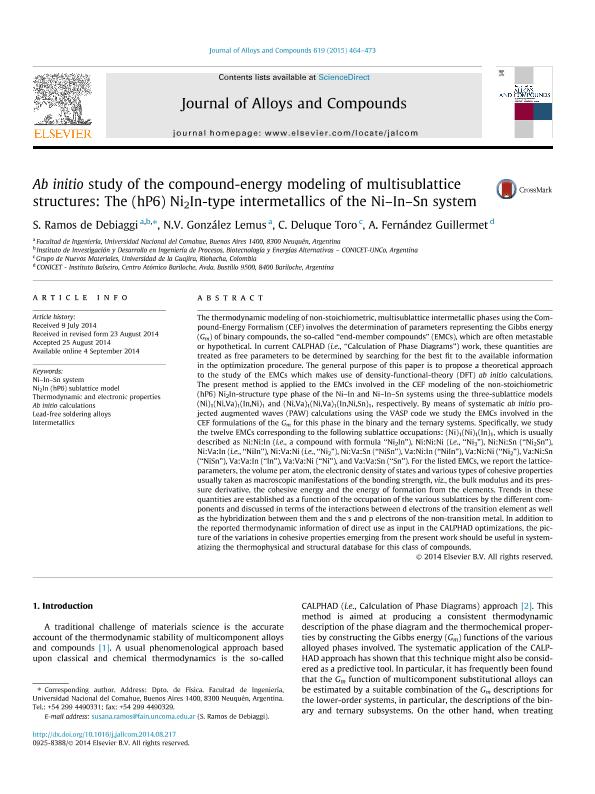Mostrar el registro sencillo del ítem
dc.contributor.author
Ramos, Susana Beatriz

dc.contributor.author
Gonzalez Lemus, Nasly Vanessa

dc.contributor.author
Deluque Toro, C.
dc.contributor.author
Fernandez Guillermet, Armando Jorge

dc.date.available
2017-01-19T20:38:43Z
dc.date.issued
2014-01
dc.identifier.citation
Ramos, Susana Beatriz; Gonzalez Lemus, Nasly Vanessa; Deluque Toro, C.; Fernandez Guillermet, Armando Jorge; Ab initio study of the compound-energy modeling of multisublattice structures: the (hP6) Ni2In-type intermetallics of the Ni–In–Sn system; Elsevier Science; Journal Of Alloys And Compounds; 619; 1-2014; 464-473
dc.identifier.issn
0925-8388
dc.identifier.uri
http://hdl.handle.net/11336/11667
dc.description.abstract
The thermodynamic modeling of non-stoichiometric, multisublattice intermetallic phases using the Compound-Energy Formalism (CEF) involves the determination of parameters representing the Gibbs energy (Gm) of binary compounds, the so-called ‘‘end-member compounds’’ (EMCs), which are often metastable or hypothetical. In current CALPHAD (i.e., ‘‘Calculation of Phase Diagrams’’) work, these quantities are treated as free parameters to be determined by searching for the best fit to the available information in the optimization procedure. The general purpose of this paper is to propose a theoretical approach to the study of the EMCs which makes use of density-functional-theory (DFT) ab initio calculations. The present method is applied to the EMCs involved in the CEF modeling of the non-stoichiometric (hP6) Ni2In-structure type phase of the Ni–In and Ni–In–Sn systems using the three-sublattice models (Ni)1(Ni,Va)1(In,Ni)1 and (Ni,Va)1(Ni,Va)1(In,Ni,Sn)1, respectively. By means of systematic ab initio projected augmented waves (PAW) calculations using the VASP code we study the EMCs involved in the CEF formulations of the Gm for this phase in the binary and the ternary systems. Specifically, we study the twelve EMCs corresponding to the following sublattice occupations: (Ni)1(Ni)1(In)1, which is usually described as Ni:Ni:In (i.e., a compound with formula ‘‘Ni2In’’), Ni:Ni:Ni (i.e., ‘‘Ni3’’), Ni:Ni:Sn (‘‘Ni2Sn’’), Ni:Va:In (i.e., ‘‘NiIn’’), Ni:Va:Ni (i.e., ‘‘Ni2’’), Ni:Va:Sn (‘‘NiSn’’), Va:Ni:In (‘‘NiIn’’), Va:Ni:Ni (‘‘Ni2’’), Va:Ni:Sn (‘‘NiSn’’), Va:Va:In (‘‘In’’), Va:Va:Ni (‘‘Ni’’), and Va:Va:Sn (‘‘Sn’’). For the listed EMCs, we report the latticeparameters, the volume per atom, the electronic density of states and various types of cohesive properties usually taken as macroscopic manifestations of the bonding strength, viz., the bulk modulus and its pressure derivative, the cohesive energy and the energy of formation from the elements. Trends in these quantities are established as a function of the occupation of the various sublattices by the different components and discussed in terms of the interactions between d electrons of the transition element as well as the hybridization between them and the s and p electrons of the non-transition metal. In addition to the reported thermodynamic information of direct use as input in the CALPHAD optimizations, the picture of the variations in cohesive properties emerging from the present work should be useful in systematizing the thermophysical and structural database for this class of compounds.
dc.format
application/pdf
dc.language.iso
eng
dc.publisher
Elsevier Science

dc.rights
info:eu-repo/semantics/openAccess
dc.rights.uri
https://creativecommons.org/licenses/by-nc-nd/2.5/ar/
dc.subject
Ni-In-Sn System
dc.subject
Ni2in (Hp6) Sublattice Model
dc.subject
Thermodynamic And Electronic Properties
dc.subject
Ab Initio Calculations
dc.subject
Lead-Free Soldering Alloys
dc.subject
Intermetallics
dc.subject.classification
Física de los Materiales Condensados

dc.subject.classification
Ciencias Físicas

dc.subject.classification
CIENCIAS NATURALES Y EXACTAS

dc.title
Ab initio study of the compound-energy modeling of multisublattice structures: the (hP6) Ni2In-type intermetallics of the Ni–In–Sn system
dc.type
info:eu-repo/semantics/article
dc.type
info:ar-repo/semantics/artículo
dc.type
info:eu-repo/semantics/publishedVersion
dc.date.updated
2017-01-17T19:22:32Z
dc.journal.volume
619
dc.journal.pagination
464-473
dc.journal.pais
Países Bajos

dc.journal.ciudad
Ámsterdam
dc.description.fil
Fil: Ramos, Susana Beatriz. Consejo Nacional de Investigaciones Científicas y Técnicas. Centro Científico Tecnológico Patagonia Norte. Instituto de Investigación y Desarrollo En Ingeniería de Procesos, Biotecnología y Energías Alternativas; Argentina. Universidad Nacional del Comahue. Facultad de Ingeniería; Argentina
dc.description.fil
Fil: Gonzalez Lemus, Nasly Vanessa. Universidad Nacional del Comahue. Facultad de Ingeniería. Departamento de Física; Argentina. Consejo Nacional de Investigaciones Científicas y Técnicas; Argentina
dc.description.fil
Fil: Deluque Toro, C.. Universidad de la Guajira. Grupo de Nuevos Materiales; Colombia
dc.description.fil
Fil: Fernandez Guillermet, Armando Jorge. Comisión Nacional de Energía Atómica. Gerencia del Area de Energía Nuclear. Instituto Balseiro; Argentina. Comisión Nacional de Energía Atómica. Gerencia del Area de Investigación y Aplicaciones No Nucleares. Gerencia de Física (Centro Atómico Bariloche); Argentina. Consejo Nacional de Investigaciones Científicas y Técnicas; Argentina
dc.journal.title
Journal Of Alloys And Compounds

dc.relation.alternativeid
info:eu-repo/semantics/altIdentifier/url/http://www.sciencedirect.com/science/article/pii/S0925838814020921
dc.relation.alternativeid
info:eu-repo/semantics/altIdentifier/url/http://dx.doi.org/10.1016/j.jallcom.2014.08.217
Archivos asociados
